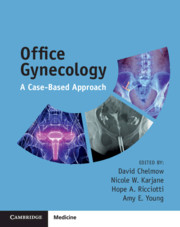Book contents
- Office Gynecology
- Office Gynecology
- Copyright page
- Contents
- Contributors
- Preface
- Section I Pelvic Pain
- Section II Vaginal Discharge and Sexually Transmitted Infections
- Section III Amenorrhea and Abnormal Vaginal Bleeding
- Section IV Contraception and Abortion
- Case 22 A 25-Year-Old Woman with No IUD String Visible One Year after Placement (IUD in Uterus)
- Case 23 A 29-Year-Old HIV-Positive Woman Requesting Oral Contraceptive Pills
- Case 24 A 42-Year-Old Woman with IUD and Actinomyces on Cervical Cytology
- Case 25 A 25-Year-Old Woman with a History of Pulmonary Embolism on OCPs Who Desires Contraception
- Case 26 A Pregnant 22-Year-Old Woman Who Desires Long-Acting Postpartum Birth Control (Immediate Postpartum LARC)
- Case 27 A 33-Year-Old G4P4 Unable to Palpate Implant Desiring Removal
- Case 28 A 24-Year-Old Woman with a Contraceptive Implant Placed Three Weeks Ago Presents with Positive Pregnancy Test
- Case 29 A 32-Year-Old HIV-Positive Woman Requesting IUD
- Case 30 A 23-Year-Old Woman Presents Two Hours after Sexual Assault
- Case 31 A Woman with a BMI of 40 kg/m2 Requests Oral Contraceptive Pills (Efficacy of Contraceptive Methods with Obesity)
- Section V Breast Problems
- Section VI Cancer Screening and Prevention
- Section VII Vulvar Disease
- Section VIII Infertility
- Section IX Preconception Planning
- Section X Pediatric and Adolescent Problems
- Section XI Pelvic Masses and Cysts
- Section XII Incontinence and Prolapse
- Section XIII Behavioral, Sexual, and Social Health
- Section XIV Managing and Aging
- Index
- References
Case 22 - A 25-Year-Old Woman with No IUD String Visible One Year after Placement (IUD in Uterus)
from Section IV - Contraception and Abortion
Published online by Cambridge University Press: 20 February 2019
- Office Gynecology
- Office Gynecology
- Copyright page
- Contents
- Contributors
- Preface
- Section I Pelvic Pain
- Section II Vaginal Discharge and Sexually Transmitted Infections
- Section III Amenorrhea and Abnormal Vaginal Bleeding
- Section IV Contraception and Abortion
- Case 22 A 25-Year-Old Woman with No IUD String Visible One Year after Placement (IUD in Uterus)
- Case 23 A 29-Year-Old HIV-Positive Woman Requesting Oral Contraceptive Pills
- Case 24 A 42-Year-Old Woman with IUD and Actinomyces on Cervical Cytology
- Case 25 A 25-Year-Old Woman with a History of Pulmonary Embolism on OCPs Who Desires Contraception
- Case 26 A Pregnant 22-Year-Old Woman Who Desires Long-Acting Postpartum Birth Control (Immediate Postpartum LARC)
- Case 27 A 33-Year-Old G4P4 Unable to Palpate Implant Desiring Removal
- Case 28 A 24-Year-Old Woman with a Contraceptive Implant Placed Three Weeks Ago Presents with Positive Pregnancy Test
- Case 29 A 32-Year-Old HIV-Positive Woman Requesting IUD
- Case 30 A 23-Year-Old Woman Presents Two Hours after Sexual Assault
- Case 31 A Woman with a BMI of 40 kg/m2 Requests Oral Contraceptive Pills (Efficacy of Contraceptive Methods with Obesity)
- Section V Breast Problems
- Section VI Cancer Screening and Prevention
- Section VII Vulvar Disease
- Section VIII Infertility
- Section IX Preconception Planning
- Section X Pediatric and Adolescent Problems
- Section XI Pelvic Masses and Cysts
- Section XII Incontinence and Prolapse
- Section XIII Behavioral, Sexual, and Social Health
- Section XIV Managing and Aging
- Index
- References
- Type
- Chapter
- Information
- Office GynecologyA Case-Based Approach, pp. 65 - 67Publisher: Cambridge University PressPrint publication year: 2019

